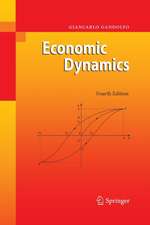Nonlinear Economic Dynamics
Autor Tönu Puuen Limba Engleză Paperback – 23 sep 2011
Preț: 388.52 lei
Nou
Puncte Express: 583
Preț estimativ în valută:
74.36€ • 76.63$ • 62.78£
74.36€ • 76.63$ • 62.78£
Carte tipărită la comandă
Livrare economică 01-15 martie
Preluare comenzi: 021 569.72.76
Specificații
ISBN-13: 9783642645495
ISBN-10: 3642645496
Pagini: 304
Ilustrații: X, 288 p.
Dimensiuni: 155 x 235 x 16 mm
Greutate: 0.43 kg
Ediția:4th ed. 1997. Softcover reprint of the original 4th ed. 1997
Editura: Springer Berlin, Heidelberg
Colecția Springer
Locul publicării:Berlin, Heidelberg, Germany
ISBN-10: 3642645496
Pagini: 304
Ilustrații: X, 288 p.
Dimensiuni: 155 x 235 x 16 mm
Greutate: 0.43 kg
Ediția:4th ed. 1997. Softcover reprint of the original 4th ed. 1997
Editura: Springer Berlin, Heidelberg
Colecția Springer
Locul publicării:Berlin, Heidelberg, Germany
Public țintă
ResearchCuprins
1 Introduction.- 1.1 Dynamics Versus Equilibrium Analysis.- 1.2 Linear Versus Nonlinear Modelling.- 1.3 Perturbation Methods.- 1.4 Structural Stability.- 1.5 Chaos and Fractals.- 1.6 The Choice of Topics Included.- 2 Differential Equations.- 2.1 The Phase Portrait.- 2.2 Linear Systems.- 2.3 Structural Stability.- 2.4 Limit Cycles.- 2.5 The Hopf Bifurcation.- 2.5 The Saddle-Node Bifurcation.- 2.7 Perturbation Methods: Poincaré-Lindstedt.- 2.8 Perturbation Methods: Two-Timing.- 2.9 Forced Oscillators: van der Pol.- 2.10 Forced Oscillators: Duffing.- 2.11 Chaos.- 2.12 A Short History of Chaos.- 3 Iterated Maps.- 3.1 Introduction.- 3.2 The Logistic Map.- 3.3 The Lyapunov Exponent.- 3.4 Symbolic Dynamics.- 3.5 Sarkovskii’s Theorem and the Schwarzian Derivative.- 3.6 The Hénon Model.- 3.7 Lyapunov Exponents in 2D.- 3.8 Fractals and Fractal Dimension.- 3.9 The Mandelbrot Set.- 4 Monopoly.- 4.1 Introduction.- 4.2 The Model.- 4.3 Adaptive Search.- 4.4 Numerical Results.- 4.5 Fixed Points and Cycles.- 4.6 Chaos.- 4.7 A Case with Two Products.- 4.8 Discussion.- 5 Duopoly and Oligopoly.- 5.1 Introduction.- 5.2 The Cournot Model.- 5.3 Stackelberg Equilibria.- 5.4 The Iterative Process.- 5.5 Stability of the Cournot Point.- 5.6 Periodic Points and Chaos.- 5.7 Adaptive Expectations.- 5.8 Adjustments Including Stackelberg Points.- 5.9 Oligopoly with Three Firms.- 5.10 Stackelberg Action Reconsidered.- 5.11 The Iteration with Three Oligopolists.- 5.12 Back to “Duopoly”.- 5.13 Changing the Order of Adjustment.- 6 Business Cycles: Continuous Time.- 6.1 The Multiplier-Accelerator Model.- 6.2 The Original Model.- 6.3 Nonlinear Investment Functions and Limit Cycles.- 6.4 Limit Cycles: Existence.- 6.5 Limit Cycles: Asymptotic Approximation.- 6.6 Limit Cycles: Transients andStability.- 6.7 The Two-Region Model.- 6.8 The Persistence of Cycles.- 6.9 Perturbation Analysis of the Coupled Model.- 6.10 The Unstable Zero Equilibrium.- 6.11 Other Fixed Points.- 6.12 Properties of Fixed Points.- 6.13 The Arbitrary Phase Angle.- 6.14 Stability of the Coupled Oscillators.- 6.15 The Forced Oscillator.- 6.16 The World Market.- 6.17 The Small Open Economy.- 6.18 Stability of the Forced Oscillator.- 6.19 Catastrophe.- 6.20 Period Doubling and Chaos.- 6.21 Relaxation Cycles.- 6.22 Relaxation: The Autonomous Case.- 6.23 Relaxation: The Forced Case.- 6.24 Three Identical Regions.- 6.25 On the Existence of Periodic Solutions.- 6.26 Stability of Three Oscillators.- 6.27 Simulations.- 7 Business Cycles: Continuous Space.- 7.1 Introduction.- 7.2 Interregional Trade.- 7.3 The Linear Model.- 7.4 Coordinate Separation.- 7.5 The Square Region.- 7.6 The Circular Region.- 7.7 The Spherical Region.- 7.8 The Nonlinear Spatial Model.- 7.9 Dispersive Waves.- 7.10 Standing Waves.- 8 Business Cycles: Discrete Time.- 8.1 Introduction.- 8.2 Investments.- 8.3 Consumption.- 8.4 The Cubic Iterative Map.- 8.5 Fixed Points, Cycles, and Chaos.- 8.6 Formal Analysis of Chaotic Dynamics.- 8.7 Coordinate Transformation.- 8.8 The Three Requisites of Chaos.- 8.9 Symbolic Dynamics.- 8.10 Brownian Random Walk.- 8.11 Digression on Order and Disorder.- 8.12 The General Model.- 8.13 Relaxation Cycles.- 8.14 The Slow Feed Back.- 8.15 The Autonomous Term: Changes of Fixed Points.- 8.16 The Autonomous Term: Response of the Chaotic Process.- 8.17 Lyapunov Exponents and Fractal Dimensions.- 8.18 Non-Relaxation Cycles.- 8.19 Conclusion.- References.















